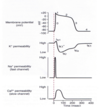Cardiac electrophysiology Flashcards
Can non-pacemaker myocardial cells turns into pacemaker cells?
Yes
what ion concentration influx dominates to generate action potentials in non-pacemaker myocardial cells?
Sodium influx
What type of cells is this actional potentials generated in?
How do you know?

non-pacemaker myocardiac cells
there is flat line of resting membrane potential after repolarization
What happen during phase 0 of action potentials?

the Na+ flows into the cell -> depolarization (cells become more positive inside) -> action potentials if pass threshold
How does the phase 4 - phase of achieving resting membrane potential different btw non-pacemaker & pacemaker cells?
the phase 4 of non-pacemaker cells has flat fline right of RMP after repolarization
the phase 4 of pacemaker cells has RMP shifting toward zero immediately after repolarizaton

How are the action potentials in pacemaker cells generated?
increase of Ca2+ & Na+ influx with increased membrane resistance to K+ permeability

How does the pacemaker cell transmit action potentials from one cell to another?
via intercalated disk
gap junction
What ion concetration influx dominate to generate action potentials of pacemaker cells?
the Ca2+ influx
Why does the pacemaker cell in SA node control the HR?
because it depolarize at faster rate (take less time to reach threshold)
What happen during phase 1 of action potentials?

the Na+ concentration is at the equilibrium -> Na+ channels inactivated
and the K+ channels start opening -> repolarization
intercalated disk
the joint at cells pack together and form low resitance bridge
gap junction
where the cell membrane fuse together and form the electrolytes channel
When does bradycardia happen?
What is the consequence?
What will happen to compensate this consequence?
when the SA node decreasing its fire rate
lower HR than normal
AV node will take over the control of ventricular beat
What happen during phase 2 of action potentials?

the plateau occur due to the activation of Ca2+ channels (Ca2+ influx) & the close of some K+ channels
inotropic factors
Two type of this factor
the chemical reagents that influence the force contraction of the heart
postive and negative
What happen during phase 3 of action potentials? and phase 4?

K+ channels open again while Ca2+ closes
the K+ concentration reach equilibrium -> achieve resting membrane potential
By what two systems that the heart rate is regulated?
autonomic system
endocrine system
What does the autonomic system consist of?
parasympathetic nervous system
sympathetic nervous system
What does the myocardial action potential conductivity velocities depend on?
length constant, which is the function of myocardial cell diameter
What nerve carry the electrical signals that decrease the HR?
What part of nervous system is it?
vagus nerve
parasympathetic NS
What chemical subtance that decrease the HR?
What is the mechanism of it?
Achetylcholine (Ach)
Ach increases the K+ conductance -> hyperpolarization longer
What nerve is activated during exercise or emotional stress to increase HR?
cardiac plexus
chronotropic factor
the chemical agents that influence the heart rate
Does the parasympathetic NS & sympathetic NS work together at same time to influence HR?
Yes, they do
What is the benefit of individual pacemaker myocardial cell stacked upon one another?
you can stimulate anywhere on the heart and the electrical impulse still distribute
During exercise, HR increases due to what?
decreases in vagus tone & increase in cardiac plexus
Catecholamine
What is its efect on HR?
Where is it released into?
group of hormones that released during physical or emotional sress
increase the HR
in blood circulation
Effect of Norepinephrine on HR?
When is it released?
increase the HR
during exercise & emotional stress
What happen to the normal HR with an extended period of training?
Why?
Does the cardiac output decrease? Explain
normal HR decreases due to increased vagal tone
the cardiac output is the same due to increase stroke volume
Where are the adrenal glands?
What do they do?
on top of the kidney
release catecholamines into blood stream in response to stress
What chemical signals that control HR at rest?
What is the nerve that signal this release?
Acetylcholine (Ach)
vagus nerve
positive chronotropic factor
Examples?
the chemical agents that increase the HR
Norepinephrine & epinephrine
What type of family chemical are epinephrine & norepinephrine related to?
What is the effect of this family chemical?
catecholamine
increase HR
Effect of Acetylcholine (Ach) on HR?
Is it positive or negative chronotropic
What graph does Ach effect illustrate?

decrease HR
negative chronotropic
graph C
How does the SV and HR of athelete differ from normal person?
SV increase
HR decrease
How does the norepinephrine & epinephrine increase the HR?
Explain in term of generating action potentials
Which graph represent these two chemical effects?

the local Ca2+ concentration increases -> less time of depolarization -> heart beat faster
Graph A


